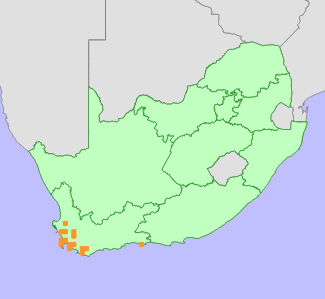|
Scientific Name | Trianoptiles capensis (Steud.) Harv. |
Higher Classification | Monocotyledons |
Family | CYPERACEAE |
Synonyms | Carpha capensis (Steud.) H.Pfeiff., Ecklonea capensis Steud. |
National Status |
Status and Criteria | Near Threatened B2ab(ii,iii,iv,v) |
Assessment Date | 2013/11/29 |
Assessor(s) | M. Muasya & L. von Staden |
Justification | A widespread (EOO 46 139 km²), and formerly common species that is becoming increasingly rare due to ongoing habitat loss and degradation, as well as competition from alien invasive plants. AOO, estimated based on extent of remaining habitat is <500 km², and an estimated 10 to 20 remaining locations continue to decline. |
Distribution |
Endemism | South African endemic |
Provincial distribution | Western Cape |
Range | Piketberg and Tulbagh to the Cape Peninsula and eastwards to Knysna. |
Habitat and Ecology |
Major system | Terrestrial |
Major habitats | Breede Shale Renosterveld, Swartland Granite Renosterveld, Elgin Shale Fynbos, Peninsula Granite Fynbos, Boland Granite Fynbos, Elim Ferricrete Fynbos, Agulhas Sand Fynbos, Hangklip Sand Fynbos, Cape Flats Sand Fynbos, Atlantis Sand Fynbos, Leipoldtville Sand Fynbos, Knysna Sand Fynbos, Lourensford Alluvium Fynbos, Breede Alluvium Fynbos |
Description | Damp flats and lower slopes. |
Threats |
| Urban expansion has caused extensive decline of subpopulations on the Cape Peninsula and Cape Flats. Elsewhere, this species continues to be threatened by habitat loss to crop cultivation, and damming and drainage of wetlands and streams for agricultural expansion. Much of this species' remaining habitat is densely infested by unmanaged alien invasive plants. |
Population |
Historical records indicate that Trianoptiles capensis was formerly common on the Cape Peninsula and Cape Flats, but most of these subpopulations are now locally extinct due to habitat loss to urban expansion. It survives only in a few protected areas such as Kenilworth Race Course and the Cape Point section of the Table Mountain National Park. Further north across the Cape Coastal Lowlands, and south-eastwards towards the Agulhas Plain, records are more sporadic, but this grass-like herb may also be overlooked. Even in these areas, it continues to suffer ongoing habitat loss and degradation, and very little of its natural habitat remains. It is also known from one historical record from around Knysna, but this species is yet to be recorded in the coastal plains between Cape Agulhas and Knysna. More surveys are needed to more accurately determine the abundance and exact range of this species.
|
Population trend | Decreasing |
Assessment History |
Taxon assessed |
Status and Criteria |
Citation/Red List version | | Trianoptiles capensis (Steud.) Harv. | NT B2ab(ii,iii,iv,v) | 2014.1 | | Trianoptiles capensis (Steud.) Harv. | Least Concern | 2013.1 | | Trianoptiles capensis (Steud.) Harv. | Least Concern | Raimondo et al. (2009) | |
Bibliography |
Goldblatt, P. and Manning, J.C. 2000. Cape Plants: A conspectus of the Cape Flora of South Africa. Strelitzia 9. National Botanical Institute, Cape Town.
Levyns, M.R. 1943. A revision of Trianoptiles Fenzl. Journal of South African Botany 9:21-26.
Manning, J.C. and Goldblatt, P. 2012. Plants of the Greater Cape Floristic Region 1: The Core Cape Flora. Strelitzia 29. South African National Biodiversity Institute, Pretoria.
Raimondo, D., von Staden, L., Foden, W., Victor, J.E., Helme, N.A., Turner, R.C., Kamundi, D.A. and Manyama, P.A. 2009. Red List of South African Plants. Strelitzia 25. South African National Biodiversity Institute, Pretoria.
|
Citation |
| Muasya, M. & von Staden, L. 2013. Trianoptiles capensis (Steud.) Harv. National Assessment: Red List of South African Plants version 2024.1. Accessed on 2025/11/02 |
 Comment on this assessment
Comment on this assessment


